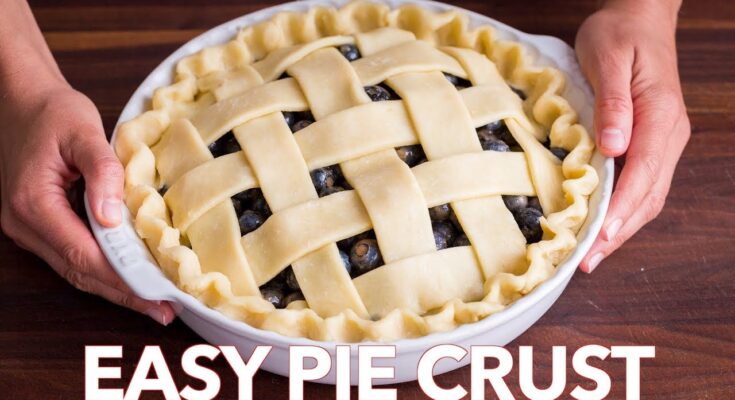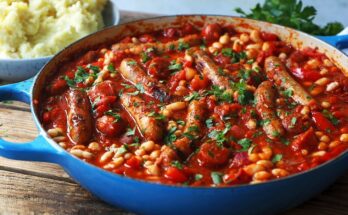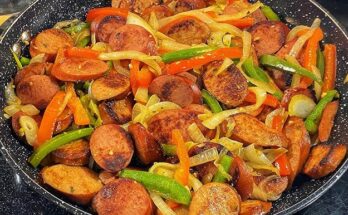Pie Crust Recipe: Nothing beats a homemade pie crust—it’s flaky, buttery, and makes your pie stand out. While it may seem intimidating to some, making pie crust from scratch isn’t as hard as you think. Whether you’re making a classic apple pie or a savory quiche, mastering this simple recipe is a game-changer. Once you follow this step-by-step guide, you’ll never go back to store-bought crusts!
What You’ll Need for the Perfect Pie Crust
Before we dive into the process, make sure you have all the necessary tools and ingredients. Here’s what you’ll need:
Tools:
- Mixing bowls
- Pastry cutter or food processor
- Measuring cups and spoons
- Rolling pin
- Plastic wrap
- Pie dish
- Fork or knife for crimping
Ingredients:
- All-purpose flour
- Unsalted butter (or shortening/lard)
- Sugar (optional, for sweet crusts)
- Salt
- Ice water
Types of Fat You Can Use in Pie Crust
The fat you choose directly impacts the taste and texture of your pie crust. Here are your main options:
- Butter: Gives a rich, buttery flavor and flaky texture.
- Shortening: Makes the crust more tender and holds its shape well.
- Lard: Great for super-flaky crusts but has a stronger flavor.
Some bakers even mix fats (like butter and shortening) to get the best of both worlds!
Flour Matters: Choosing the Right Flour
All-purpose flour is ideal for most pie crusts, but if you want an even softer texture, you can try using pastry flour. Keep in mind that too much protein (like in bread flour) will make the dough tough.
The Importance of Cold Ingredients
Temperature is key when making pie dough. Warm butter or water can make the dough sticky and hard to work with. Always use chilled butter and ice-cold water to get the best flaky results.
Step-by-Step Instructions for a Perfect Pie Crust
Step 1: Gather Your Ingredients
You’ll need:
- 2 ½ cups all-purpose flour
- 1 cup (2 sticks) unsalted butter, chilled and cut into cubes
- 1 tsp salt
- 1 tbsp sugar (optional)
- 6-8 tbsp ice-cold water
Step 2: Mix the Dry Ingredients
In a large mixing bowl, whisk together the flour, salt, and sugar. This ensures the dry ingredients are evenly distributed.
Step 3: Cut in the Fat (Butter/Shortening)
Add the chilled butter cubes to the flour mixture. Using a pastry cutter (or your fingertips), work the butter into the flour until the mixture resembles coarse crumbs. If you prefer using a food processor, pulse the mixture a few times to get the same effect.
Step 4: Add Ice-Cold Water Gradually
Sprinkle 1 tablespoon of ice water at a time into the flour mixture. Gently mix with a fork after each addition. Stop adding water when the dough just comes together—it should still look a little shaggy.
Step 5: Form the Dough into a Disk
Once the dough starts coming together, turn it out onto a floured surface. Gather it into a ball and gently press it into a disk shape. Be careful not to overwork the dough—this is what keeps it tender.
Step 6: Chill the Dough
Wrap the dough disk in plastic wrap and refrigerate for at least 30 minutes. Chilling helps relax the gluten and makes the dough easier to roll out.
Step 7: Roll Out the Dough
After chilling, take the dough out and let it sit for a few minutes to soften slightly. Roll it out on a floured surface to about ⅛ inch thick. Keep turning the dough to avoid sticking.
Step 8: Transfer the Dough to the Pie Dish
Gently roll the dough onto your rolling pin and unroll it over the pie dish. Press it gently into the edges without stretching. Trim any excess dough, leaving about a ½-inch overhang.
Step 9: Crimping and Decorating the Edges
Use your fingers or a fork to crimp the edges of the crust. If you want a more decorative touch, try making a fluted edge or braiding thin strips of dough.
Step 10: Pre-baking or Blind Baking the Crust
For some recipes, you’ll need to bake the crust before adding the filling. To blind bake, cover the dough with parchment paper and fill it with pie weights or dried beans. Bake at 375°F (190°C) for 15-20 minutes until lightly golden.
How to Roll Out the Pie Dough
- Lightly flour your surface and rolling pin to prevent sticking.
- Roll the dough from the center outward, applying even pressure.
- Aim for a thickness of about 1/8 inch.
- Carefully transfer the rolled-out dough to your pie dish.
Tips for Avoiding Common Pie Crust Mistakes
- Don’t overwork the dough. Over-mixing develops gluten, leading to a tough crust.
- Keep ingredients cold. Warm butter will melt and ruin the texture.
- Use parchment paper. It prevents sticking when rolling out the dough.
How to Blind Bake a Pie Crust (For Pre-Baked Pies)
Blind baking is essential when your filling doesn’t require baking.
- Line the pie crust with parchment paper and fill with pie weights or beans.
- Bake at 375°F (190°C) for 15-20 minutes until the edges are lightly golden.
Pie Crust Variations You Can Try
- Whole Wheat Crust: Replace half the flour with whole wheat flour.
- Gluten-Free Crust: Use a 1:1 gluten-free flour mix.
- Flavored Crusts: Add cocoa powder or cinnamon to the dough for a unique twist.
Troubleshooting Pie Crust Issues
- Tough Crust: Likely caused by over-mixing or too much water.
- Shrinking Crust: The dough may not have rested long enough before baking.
How to Store and Freeze Pie Dough
- In the fridge: Wrapped tightly, it will keep for up to 3 days.
- In the freezer: Store for up to 3 months. Thaw in the fridge overnight before using.
Creative Ways to Use Leftover Pie Dough
- Make mini tarts or hand pies.
- Use dough scraps to create a lattice top.
- Bake pie crust cookies sprinkled with cinnamon sugar.
What to Pair with Your Perfect Pie Crust
- Sweet Pies: Try apple, pumpkin, or cherry filling.
- Savory Pies: Use it for quiche or chicken pot pie.
The Secret to Flaky Pie Crust Every Time
The secret lies in keeping everything cold and handling the dough minimally. Cold butter creates steam pockets as it melts, resulting in the layers that give pie crust its signature flakiness.
Tips for Troubleshooting Common Issues
- Crust Shrinks: Make sure to chill the dough thoroughly before baking.
- Dough Cracks: Patch small cracks with leftover dough.
- Overworked Dough: Be gentle while handling the dough to keep it flaky.
FAQs about Pie Crust Recipe
1. What ingredients do I need for a basic pie crust?
A classic pie crust requires just a few ingredients: flour, butter (or shortening), salt, and water. Some recipes also include sugar for a hint of sweetness.
2. What is the secret to a flaky pie crust?
The key to a flaky crust is cold butter and minimal handling. Keep your butter chilled and work quickly to avoid melting it before baking.
3. Can I use a food processor to make pie dough?
Yes, a food processor makes pie dough preparation faster. Just be careful not to over-process the dough, as this can make it tough.
4. How long should I chill pie dough before rolling it out?
Chilling the dough for at least 30 minutes to 1 hour allows the gluten to relax, making it easier to roll and preventing shrinking during baking.
5. How do I prevent the crust from becoming soggy?
Pre-baking (blind baking) the crust helps prevent sogginess. You can also brush the crust with egg wash or melted butter before adding the filling.
6. What can I do if my dough cracks while rolling?
If the dough cracks, press it back together gently with your fingers. If it’s too dry, sprinkle a little water and knead lightly to fix it.
7. Can I freeze pie dough for later use?
Yes, pie dough freezes well for up to three months. Wrap it tightly in plastic wrap and store in a freezer bag. Thaw overnight in the fridge before using.
8. How do I get a golden-brown pie crust?
Brush the crust with egg wash (a mix of egg and water) or milk before baking to achieve a beautiful golden finish.
9. Can I make pie crust gluten-free?
Absolutely! You can use gluten-free flour blends available in stores or mix your own with rice flour, almond flour, and starches.
10. How can I make the crust decorative?
Use tools like cookie cutters or a fork to create patterns on the edges, or braid strips of dough for an elegant touch.
Conclusion
Mastering pie crust takes patience and practice, but it’s well worth the effort. Once you get the hang of balancing ingredients and achieving that perfect flaky texture, your homemade pies will stand out every time. The key lies in keeping your ingredients cold, handling the dough gently, and not overmixing—simple steps that make all the difference.
Once you’ve nailed the crust, the fun really begins! Don’t limit yourself to classic options like apple or pumpkin—explore new flavors and textures. Try savory fillings like spinach and feta or sweet twists like berry medleys. Your creativity with fillings will transform an ordinary pie into a memorable dish. Embrace the process, and let each attempt inspire new ideas!
References
To ensure accuracy and provide additional resources for readers looking to perfect their pie crust recipe, it’s essential to cite reputable sources. These references offer detailed insights and expert advice that validate the information shared. For further reading and in-depth tips on making the best pie crust, consider the following:
- Food Network – Perfect Pie Crust Tips
- Sally’s Baking Addiction – Flaky Homemade Pie Crust Guide
- The Kitchn – How to Make Pie Crust from Scratch
These sources are well-regarded in the culinary world and can help enhance your baking experience.



